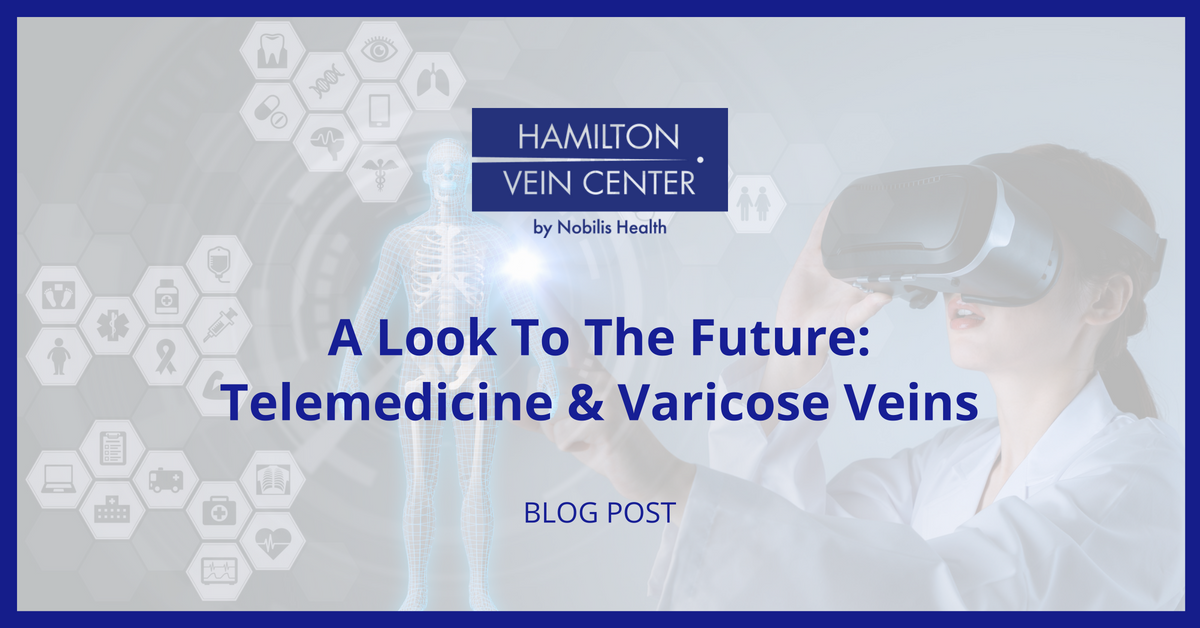A Look To The Future: Telemedicine & Varicose Veins

Making Medicine Accessible
Especially for those living in more rural areas, there’s a great deal of allure when it comes to telemedicine. The ability to receive medical consultations at home using online interfaces and smart devices has the potential to take on the challenge of delivering care to more remote areas. It allows those for whom getting to the hospital is difficult or tremendously inconvenient to get the necessary, non-emergency care they need.
For patients with varicose veins or other vein conditions, telemedicine approaches promise to make access to diagnosis and follow-up care easier than ever. And this is important as, according to recent surveys, an estimated 65 million Americans live in a “primary care desert,” that is an area where the total number of primary care doctors can only meet the needs of 50 percent or less of the population. Reflecting an overall shortage of physicians, the average wait time to see a new doctor in the US increased by 51 percent from 2014 to 2017. [1] Clearly, there’s problem.
But while many of these telemedical technologies are newer or in their infancy, recent studies have highlighted their success. So much so that one team of doctors at the University of Texas, Houston, has piloted a home screening program for those with varicose veins. [2]
Diagnosis At Your Own Digs
Proper diagnosis is the first step in treatment; in the case of varicose veins, doctors need to assess vital health information as well as the area to be treated itself. The UT program allows patients to answer a questionnaire about their condition and send along pictures of their legs for visual assessment. Based on what they see, they can recommend patients to follow-up and seek treatment. [2] What could be a long commute and waiting time can occur nearly instantaneously.
It’s a vital first step, says Dr. Stuart Harlin, who runs the program, and it’s helped him make an immediate impact on his patients’ health. “I helped a young mother who had disabling symptoms from her varicose veins. She experienced pain and swelling to the degree that she could not exercise or work in her garden,” Harlin recalled. “She underwent treatment for her varicose veins and has returned to an active lifestyle including competitive sports.” [2] Timely intervention here and in other cases means better health outcomes overall.
Smartphones Vs. Sickness
Programs like the one at the University of Texas are just the beginning. There’s no doubt that technological development will only further the potential of telemedicine. One area of growth and development in this field involves the use of smartphones and other devices to create a smoother interface between patient data and vitals and medical consultation and care. In the field of cardiac health, for instance, such systems are already able to track important markers such as heart rate and blood pressure, relaying them back to doctors and caregivers. [3]
Wearers of FitBit or related devices can already see the potential as it’s the biological and physical information these track that lets them know how many calories they’ve burned or steps they’ve taken. Telemedicine, potentially, can further harness these devices. For instance, a smartphone could raise red flag to you and your doctor if you’re not getting enough exercise, are not taking necessary medications, or are eating unhealthily. According to Drs. John G. F. Cleland and David Barrett writing in the European Cardiology Review, this freer exchange of health information will benefit all parties involved by “empowering patients to take control of their management,” while also “[r]educing the demands on health professionals” by streamlining the care process. [3]
A Brighter Future
While there’s of course more work to be done with telemedicine, there’s little doubt that accessibility to medical care will continue to improve. In fact, these approaches have already been shown to help taking on more complicated conditions like liver cancer. [4] By creating a more responsive health care setting—one that can better cater to the needs of the patients—it’s safe to say that this will make the future brighter. There very well may be a day where all you’ll need for quality care is a reliable internet connection.
If you’re suffering from varicose veins, the team at Hamilton Vein Center is ready to help. The experts at these Texas-based outpatient clinics employ the latest in techniques and technologies to ensure positive outcomes for countless patients. Learn more about what they do by calling their Houston office at (281) 565-0033, the Austin clinic (512) 551-1403, or San Antonio at (210) 504-4304 today!
References
- Guttman, Dave. 2018. “29 Statistics You Need To Know About Healthcare & Telemedicine”. Com. Accessed July 5 2018. https://www.fshealth.com/blog/29-statistics-about-telemedicine-healthcare.
- “UT Physicians Provide No-Cost Online Varicose Vein Screening Program”. 2018. News-Medical.Net. Accessed July 5 2018. https://www.news-medical.net/news/20180424/UT-Physicians-provide-no-cost-online-varicose-vein-screening-program.aspx.
- Cleland, John G.F., and Barrett, David. “Telehealth – Future Directions In Cardiovascular Care”. 2010. Com. Accessed July 5 2018. https://www.ecrjournal.com/articles/telehealth-future-directions-cardiovascular-care.
- “Video Consultations Boost Survival Rates Of Liver Disease Patients, Study Finds”. 2018. News-Medical.Net. Accessed July 5 2018. https://www.news-medical.net/news/20180612/Video-consultations-boost-survival-rates-of-liver-disease-patients-study-finds.aspx.